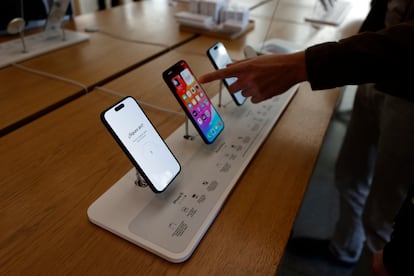Is it true that the iPhone 15 overheats?
Apple acknowledges overheating problem, blames certain apps and promises to resolve it with an update

An unexpected problem has somewhat overshadowed the launch of the iPhone 15: Apple’s flagship device overheats excessively at times and the company has been compelled to acknowledge this problem. The good news for those who have purchased the new mobile phone is that the manufacturer has promised to solve this issue urgently and will do so through a software update. This is particularly important, since it would rule out a design problem.
It is worth highlighting that the Pro version of this new iPhone model is manufactured on a titanium chassis, a much more resistant, but lighter material. This ambitious stride in design provides a tremendous advantage to cell phone users: its lightness when held. However, the reports about temperature problems that have begun to plague the internet have sparked fears among owners. Could this change in material be the cause of the overheating?
A new case of ‘heatgate’
According to scores of accounts that have emerged in recent days on social media, the first purchasers of the new model began to feel excessive heat in certain situations. But is this just a partial perception or were they really overheating? Measurements carried out using a thermal camera concluded that we were dealing with the latter: the back of the cell phone could reach around 42°C/107°F, well above normal levels, especially for a cell phone of this class.
Forums and social media centered the problem on two key scenarios: while charging the device and when launching certain applications, some of which are extremely popular, such as Instagram. The ghosts of the ‘Antennagate’ scandal resurfaced among the brand’s legion of followers as a result of the similarity of the situation. This incident also occurred after a change in the design of the device’s hardware, when Apple opted to integrate the iPhone’s antenna (in its model 4) into the mobile’s contour. Apple poured more fuel on the fire by blaming the users themselves for not holding the phone properly: “Just don’t hold it that way,” said the great Steve Jobs. However, the company ended up providing all those affected with cases that solved the problem and promptly fired one of the engineers responsible for the new design.
Apple admits and identifies problems
This time, everything seems to suggest that it is a software problem and therefore, it can be fixed with a software update. However, Apple is yet to issue an official statement or respond to this newspaper’s request, but it has acknowledged the problem to a CNET reporter. With a “we have identified a few conditions which can cause iPhone to run warmer than expected,” the manufacturer confirms the overheating and identifies three possible causes and solutions:
· A bug in iOS 17: the company has identified a problem in iOS 17 (the current version), that “is impacting some users and will be addressed in a software update.” The company source did not provide further details about this problem or its involvement in the overheating.
· Background activity during restoration: this is a situation well known to iPhone users who migrate from one model to another by restoring from backups that run in the background.
· Third-party developer software problem: Apple is pointing an accusatory finger at updates to popular apps such as Instagram or Uber, which could be behind a “system overload”.
Apple promises to find solutions but has not specified deadlines. One of the fears expressed by the owners of this Pro version is that one of the solutions will be to reduce the processor speed, or in other words, to slow down the iPhone. This would be a huge blow for those who have invested a considerable amount of money in this premium model. However, the latter does not seem likely, as the U.S. manufacturer has already been sanctioned for a similar reason by the European Union.
Sign up for our weekly newsletter to get more English-language news coverage from EL PAÍS USA Edition
Tu suscripción se está usando en otro dispositivo
¿Quieres añadir otro usuario a tu suscripción?
Si continúas leyendo en este dispositivo, no se podrá leer en el otro.
FlechaTu suscripción se está usando en otro dispositivo y solo puedes acceder a EL PAÍS desde un dispositivo a la vez.
Si quieres compartir tu cuenta, cambia tu suscripción a la modalidad Premium, así podrás añadir otro usuario. Cada uno accederá con su propia cuenta de email, lo que os permitirá personalizar vuestra experiencia en EL PAÍS.
¿Tienes una suscripción de empresa? Accede aquí para contratar más cuentas.
En el caso de no saber quién está usando tu cuenta, te recomendamos cambiar tu contraseña aquí.
Si decides continuar compartiendo tu cuenta, este mensaje se mostrará en tu dispositivo y en el de la otra persona que está usando tu cuenta de forma indefinida, afectando a tu experiencia de lectura. Puedes consultar aquí los términos y condiciones de la suscripción digital.











































